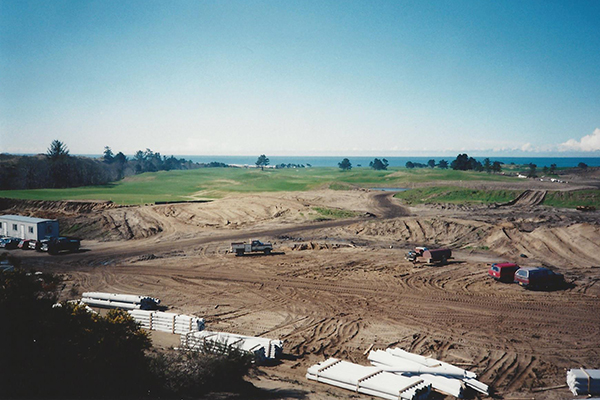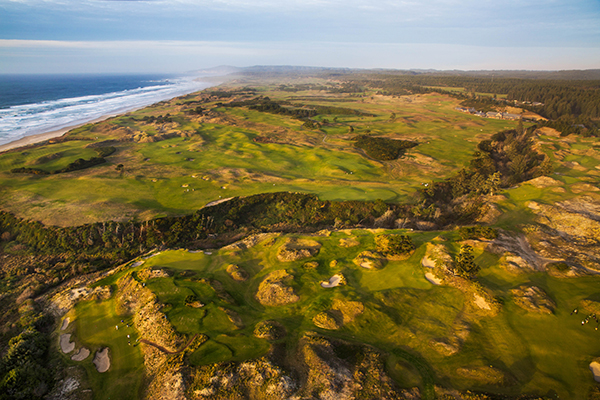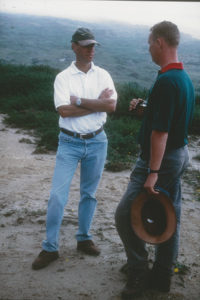Bandon Dunes marks 20 years since it changed the face of golf
by Blaine Newnham
Twenty years ago, as we searched among the sand dunes for the trailer that served as the first clubhouse at Bandon Dunes, I wondered how these guys from Chicago could possibly expect this to work.
I knew the joys of links golf after two separate trips to Ireland, but this was the United States in 1999. Players preferred to drive carts.
And this wind-swept experiment came at a time when the craggy southern Oregon coast was considered remote even for Oregonians. It’s a five-hour drive from Portland, with few available flights into the small regional airport in neighboring North Bend/Coos Bay.

Initial green fees would be $100 a round. That’s Pebble Beach territory, not for us, I thought.
Even course developer Mike Keiser, the man responsible for one the world’s great places to play golf, admits he never thought his passion would turn into a game-changing obsession.
“My initial vision was to find a sand-based site somewhere in the world that reminded me of the great links golf courses in the British Isles,” Keiser said. “No one on our team, including myself, had the foresight that the resort might grow into five courses and a golf destination that many travel to experience from around the globe.”
It was clear from the beginning that Keiser had the resources to challenge prevailing wisdom. He bought the initial piece of property north of the Coquille River from Seattle businessmen who saw hopes for a housing development awash amid political and environmental haggling.
With no debt, Keiser answered only to himself. If the course became nothing more than a playpen for his Chicago buddies, well, so be it.
“My formula,” he said recently, “is hiring great architects, building a course open to the public, and encouraging the golf experience to be enjoyed walking. All of these guidelines I believe have helped bring awareness to the way the game was first enjoyed.”
Clearly, Bandon Dunes has changed the face of American golf. It has grown to four marvelous courses – with another on the way.
Look around, from Sand Valley in Mid-America, to Cabot Cliffs on the shores of Nova Scotia, newer links courses have fewer trees and more bunkers than Bandon Dunes.
But they are being built under a similar contingency as Bandon Dunes, and that is not simply to sell real estate.

What would ultimately be called Bandon Dunes Golf Resort wasn’t designed to hold a major championship, either, although there’s already been plenty of those, including the 2020 U.S. Amateur. It was designed for what Keiser called “the retail golfer” – the 18-handicapper who loves the game and doesn’t want it to be diluted by the normal trappings of a resort.
Bandon doesn’t do conventions, or weddings, or have elegant restaurants. There aren’t spas, fancy hotel rooms or high-end shops.
When Keiser said no extra pillows for the rooms would be provided, he meant it. This is not Pinehurst or Pebble Beach.
Back then, I had an opportunity one night to go through a few pints in the downstairs Bunker Bar with Keiser and Tom Doak, the iconoclastic architect who designed the second course, Pacific Dunes, and the fourth, Old Macdonald.
From our conversation, it seems strange that the vision and vitality of Bandon came from a guy from Chicago. But Keiser admitted he had made enough money from printing cards on recycling paper that his golf projects could command his attention and vast resources.
He spent five years looking for a sandy, seaside property along the coasts of the Carolinas. A call from a real-estate agent in Gold Beach, Ore. across the country changed everything.
To get approval for his initial course, Keiser’s bid certainly wasn’t hurt by the fact the region’s economy was in a downturn, with fishing, timber and cranberry sales all down.
Civic types also saw a potential boost in tourism, which is something Bandon has certainly done.
And, not to be underestimated, the promise to abate all growing gorse, an oily weed responsible for twice burning down the town, was certainly welcomed.
After the course opened, the first summer drew plenty of players. Winter, on the other hand, was dead.

“We were from Chicago, and we thought we’d have to close during the winter,” said KemperSports president Josh Lesnik, the first general manager at Bandon.
What they ultimately discovered was that winters were shockingly nice. And with reasonable green fees to pair with temperatures in the 60s with little of the relentless wind that marks the summers, it didn’t take long for word to get out that Bandon was a year-round destination point.
Ironically, the least celebrated of the courses – Bandon Trails – put the resort over the top. Those who loved the game were coming in from everywhere.
“People would call and want to know where else they could play if they came all the way to Bandon,” said Matt Allen, a former Bandon operations manager who eventually left to take the general manager position at Chambers Bay.
“Once we had a third course, it was obvious that they could come to Bandon and just play and stay here.”
Bandon Trails was followed by Old Macdonald and then by Bandon Preserve, a 13-hole par-3 layout designed by Bill Coore and Ben Crenshaw, who had also done Trails.
All four of Bandon’s full layouts are ranked among America’s top-100 courses.
“Any pilgrimage to golf’s great destinations, you have to go through St. Andrews and Bandon Dunes,” said David McLay Kidd, the young Scot who designed the first of the Bandon Dunes four courses.
There’s little doubt that if Kidd’s course hadn’t been so universally enjoyed, there wouldn’t have been Pacific Dunes, or Bandon Trails or Old Macdonald. Perhaps Keiser’s greatest decision was having the then-26-year-old Kidd design the first course at Bandon – his first design anywhere – because Kidd knew nothing else but links golf.
There were no compromises.
People loved it; I loved it. This was a true sanctuary of links golf, where players walk and carry their clubs – where there are times that the only sound you hear is the roar of the Pacific Ocean, and the rattling of clubs as a foursome wanders by.
Blaine Newnham is a former sportswriter and columnist for The Register-Guard and The Seattle Times. He follows the way and the truth of links golf.






